
JIM BOWIE-BORN 1796; DIED DEFENDING THE ALAMO IN MARCH 1836



By Len Kubiak, Central Texas Author and Historian
James (Jim) Bowie was one of the gallant men that defended the Alamo in 1836 buying General Sam Houston precious time to build and train an army to fight Santa Anna's army. This is a biography of that gallant man!
James(Jim)Bowie, son of Reason and Elve Jones Bowie, was born near Terrapin Creek in Logan County (now Simpson County), Kentucky, about April 10, 1796.As a teenager, James Bowie worked in Louisiana, where he floated lumber to market. He invested in property on the Bayou Boeuf and traded in 1817-18 at what is now Bennett's Store, south of Cheneyville. Jim Bowie caught and rode wild horses, rode alligators, and trapped bears.
When grown, Bowie was described as "a stout, rather raw-boned man, of six feet height, weighing 180 pounds." He had light-colored hair, keen grey eyes "rather deep set in his head," a fair complexion, and high cheek-bones.
For a while, James and his brother Rezin, traded in slaves. They bought them from the pirate Jean Laffite, who captured slave shipments in the Caribbean and Gulf of Mexico and ran a slave market on Galveston Island. Laffite landed slaves at Bowie's Island in Vermilion Bay, and the Bowies took the slaves up the Vermilion and sold them in St. Landry Parish. When they had $65,000 in capital, they quit the business.
During the late 1820s, Jim Bowie and his brothers Rezin and Stephen established the Arcadia sugar plantation near the town of Thibodaux, Terrebonne Parish, where they set up the first steam-powered sugar mill in Louisiana. Jim Bowie's brother, Rezin Bowie, was elected to the Louisiana state legislature.
The Famous Bowie KnifeWhile there are many versions of the invention of the Bowie Knife (some say Jim's brother, Rezin, invented the Bowie). However,the most famous version of the Bowie knife was designed by Jim Bowie and presented to Arkansas blacksmith James Black in the form of a carved wooden model in December of 1830. Black produced the knife ordered by Bowie, and at the same time created another based on Bowie's original design but with a sharpened edge on the curved top edge of the blade. Black offered Bowie his choice and Bowie chose the modified version. Knives like that one, with a blade shaped like that of the Bowie knife, but with half or more of the back edge sharpened, are today called "Sheffield Bowie" knives, because this blade shape became so popular that cutlery factories in Sheffield, England were mass-producing such knives for export to the U.S. by 1850, usually with a handle made from either hardwood, stag horn, or bone, and sometimes with a guard and other fittings of sterling silver.[citation needed]
Bowie returned to Texas and was involved in a knife fight with three men who had been hired to kill him. Bowie killed the three would-be assassins with his new knife and the fame of the knife was established. Legend holds that one man was almost decapitated, the second was disemboweled, and the third had his skull split open. Bowie died at the Battle of the Alamo five years later and both he and his knife became immensely famous. The fate of the original Bowie knife is unknown; however, a knife bearing the engraving "Bowie No. 1" has been acquired by the Historic Arkansas Museum from a Texas collector and has been attributed to Black through scientific analysis.
Jim spent little time at his sugar plantation in Thibodaux and traveled widely to the eastern cities, as well as Arkansas and Mississippi. On February 12, 1831, the Bowie brothers sold Arcadia and other landholdings and eighty-two slaves to Natchez investors for $90,000.
JIM BOWIE COMES TO TEXAS
Bowie entered Texas which was now under Mexican control, in January of 1830, stopping at Nacogdoches, where Bowie presented a letter of introduction to empresario Stephen F. Austin from Thomas F. McKinney, one of the Old Three Hundred colonists. On February 20, 1830, Jim Bowie took the oath of allegiance to Mexico.
BOWIE BECOMES A LAND SPECULATOR
Jim Bowie and his party travelled on to Saltillo , the state capital of Coahuila and Texas. There Bowie learned that a Mexican law of 1828 offered its citizens eleven-league grants in Texas for $100 to $250 each. (A league was 4,428.4 acres.) Bowie urged Mexicans to apply for the eleven-league grants, which he purchased from them. Jim Bowie left Saltillo with fifteen or sixteen of these grants, and continued to encourage speculation in Texas lands. His activities irritated Stephen F. Austin, who hesitated to approve lands Bowie wanted to locate in the Austin colony but eventually allowed the tracts there.
BOWIE BECOMES A MEXICAN CITIZEN
In San Antonio, Bowie posed as a man of wealth, attached himself to the wealthy Veramendi family, and was baptized into the Catholic Church, sponsored by the Veramendi family. In the autumn of 1830 he accompanied the family to Saltillo, and on October 5 officially became a Mexican citizen. The citizenship was contingent on his establishing wool and cotton mills in Coahuila. Through his friend Angus McNeill of Natchez, Bowie purchased a textile mill for $20,000.
BOWIE WEDS URSULA DE VERAMENDI
On April 25, 1831, Bowie married Ursula de Veramendi in San Antonio. Ursula was the daughter of a Mexican Governor. He had appeared before the mayor, declared his age as thirty-two (he was actually thirty-five), and pledged to pay Ursula a dowry of $15,000. He valued his properties at $222,800. Bowie borrowed $1,879 from his father-in-law and $750 from Ursula's grandmother for a honeymoon trip to New Orleans and Natchez. The Bowies then settled in San Antonio.
BOWIE AND THE LOST SILVER MINES
However, James Bowie became fascinated by tales of the "lost" Los Almagres Mine, said to be somewhere west of San Antonio near the ruin of Santa Cruz de San Sab� Mission. Bowie obtained permission from Mexican authorities for an expedition on November 2, 1831. Jim left San Antonio with his brother Rezin and nine others.
BOWIE'S FIGHT WITH THE INDIANS
On the nineteenth of November, 1831, Bowie learned that a large Indian war party was following them, and six miles from San Saba, Bowie camped in an oak grove. When an attempt to parley failed. Bowie's men fought for their lives for many hours. The Indians finally drew off, reportedly leaving forty dead and thirty wounded. Bowie lost one man killed and several wounded and decided to return to to San Antonio for medical help. On January 23, 1832, Bowie made another foray to the west. He now carried the title of "colonel" of citizen rangers. Bowie left Gonzales with twenty-six men to scout the headwaters of the Colorado for hostile Indians. After a fruitless search, he returned home.
BOWIE JOINS THE FIGHT AGAINST MEXICO
In July of 1832, in Natchez, Jim Bowie learned that Jos� de las Piedras, the Mexican commander at Nacogdoches, had visited the towns of Anahuac and Velasco to quiet the antagonisms between the government and the mainly Anglo citizens. Upon his return, Piedras demanded that all citizens in his jurisdiction surrender their arms. The colonists rejected the demand.
August 1,1832, Bowie hurried to Nacogdoches accompanied by James W. Bullock and 300 armed men to help the garrison under siege. Piedras chose to fight. During the night he evacuated his men and marched south, having lost thirty-three men.
Bowie and eighteen men ambushed the Mexican column, and Piedras fled. Bowie marched the captured Mexican soldiers back to Nacogdoches.
On March 9, 1833, Monclova replaced Saltillo as the state capital. When the two towns raised small armies to contest the change, Bowie favored Monclova. On one occasion when the forces confronted each other, he rode out and tried to prevent a battle. He believed that the fortunes of Texas land speculators lay with Monclova.
CHOLERA STRIKES BOWIE'S FAMILY
In September of 1833, Ursula Bowie and her two young children died of cholera at Monclova. Bowie was ill with yellow fever in Natchez and unaware of the deaths.
BOWIE APPOINTED LAND COMMISSIONER
Mexican laws passed in 1834 and 1835 opened the floodgates to wholesale speculation in Texas lands, and Texas-Coahuila established land commissions to speed sales, since the state treasury was empty. Bowie was appointed a commissioner to promote settlement in John T. Mason's purchase. The governor also was empowered to hand out 400-league parcels for frontier defense. The sale of these large tracts angered some colonists, who also resented a rumored plan by speculators to make San Antonio the capital. They questioned Bowie's handling of Mason's 400-league purchase. One traveler met Bowie and Mason en route from Matamoros to Monclova with $40,000 to pay the last installment on Mason's land. Bowie also sold Mason land certificates to his friends in Natchez.
DRUMS OF WAR GROWING STRONGER
In May 1835, Santa Anna abolished the Coahuila-Texas government and ordered the arrest of all Texans doing business in Monclova. Bowie fled the capital for Texas. On June 22 he wrote a friend in Nacogdoches that all communication between Mexico and Texas had been cut, that troops were boarding ships at Matamoros for the Texas coast, and that Mexican forces were en route from Saltillo toward the Rio Grande. In July, Bowie and others in San Felipe and Nacogdoches were beating the drum for war. Bowie led a small group of Texas "militia" to San Antonio and seized a stack of muskets in the Mexican armory there.
On July 31, 1835, William B. Travis wrote Bowie that Texans were divided and that the Peace Party appeared the stronger. Travis was a leader of the War Party. Bowie had hired Travis as early as 1833 in San Felipe to prepare land papers, and in June 1834 Travis represented Bowie and Isaac Donoho in a case filed by Francis W. Johnson. Travis also did legal work for Bowie's friend Jesse Clifft, a blacksmith who is often credited with making the first Bowie knife.
The War Party sought military support among the Indian tribes in East Texas. On August 3, Bowie reported on a recent tour of several villages where he found many of the Indians on drunken sprees and all reluctant to cooperate.
On September 1, 1835, Austin arrived back in Texas from a long imprisonment in Mexico City. On October 3, 1835, Santa Anna abolished all state legislatures in Mexico. After being elected to command the volunteer army, Austin issued a call to arms. On October 16 his forces camped on Cibolo Creek twenty miles from San Antonio. Bowie arrived with a small party of friends, principally from Louisiana, and Austin placed him on his staff as a colonel. Travis and others joined the army. Gen. Sam Houston,in command of the Texas regular army, arrived and condemned the idea of attacking Bexar. He maintained that Austin's army, weak and ill-trained, should fall back to the Guadalupe or Colorado river.
BOWIE WINS THE BATTLE OF CONCEPCION
Bowie and Capt. James W. Fannin, at Austin's orders, scouted south of Bexar for a new campsite. On their way, Bowie drove off a Mexican patrol. On October 26,1835, Austin moved 400 men to San Francisco de la Espada Mission. Bowie took ninety-two horsemen and inspected the area of Nuestra Se�ora de la Pur�sima Concepci�n de Acu�a Mission, near Bexar. At dawn on October 28, 1835, in a heavy fog, the Mexicans attacked Bowie with 300 cavalry and 100 infantry. Bowie fought for three hours.
"Bowie was a born leader," Noah Smithwick wrote years later of the battle of Concepci�n, "never needlessly spending a bullet or imperiling a life. His voice is still ringing in my old deaf ears as he repeatedly admonished us. "Keep under cover boys and reserve your fire; we haven't a man to spare."
Bowie captured a six-pounder cannon and thirty muskets. He lost one man, while the Mexicans left sixteen on the field and carried off as many. Bowie, Fannin, and the detachment remained in the immediate area south of Bexar while Austin moved his army and established headquarters on the Alamo Canal.
Three days after the battle of Concepci�n, Austin sent Travis and fifty men to capture some 900 horses being driven south to Laredo, and asked Bowie to create a diversion to cover the escape of Mexican soldiers who wanted to desert. Bowie made a display of force, yet the soldiers failed to come out. On October 31, 1835, Bowie notified Gen. Mart�n Perfecto de Cos that he would join Austin in an attack on Bexar.
JIM BOWIE RESIGNS FROM TEXAS ARMY
On November 1, 1835, Austin demanded that Mexican General Cos surrender; he refused. Austin hesitated. On November 2, Austin's officers voted 44 to 3 against storming Bexar. Bowie did not vote. He asked the same day to be relieved of command and again tried to resign on November 6. He had earlier served in a volunteer ranger group, fought Indians, and was the type of officer who served the community in time of need. He apparently had little interest in a formal command. Provisional governor Henry Smith and Houston wanted him to raise a volunteer group and attack Matamoros, but the General Council declared that Bowie was not "an officer of the government nor army."
THE GRASS FIGHT
Bowie left the army for a brief trip to San Felipe in mid-November. He was back in San Antonio on November 18, and on the November 26, 1835, Bowie and thirty horsemen rode out to check on a Mexican packtrain near town, while Burleson followed with 100 infantry. Bowie met the train and charged its cavalry escort.
Bowie fought off several assaults by Mexican infantry, and the Mexicans retired with the loss of sixty men. As the train was loaded with bales of grass for the garrison livestock, the clash was called the Grass Fight.
Bowie subsequently proceeded to Goliad to determine conditions there. During his absence, Burleson attacked Bexar on December 5 and forced the Mexican garrison to surrender and retire to the Rio Grande. The volunteers left for home. Bowie received a letter from Houston dated December 17, suggesting a campaign against Matamoros. If that was impossible, Houston suggested, Bowie could perhaps organize a guerilla force to harass the Mexican army. The Matamoros expedition was approved, but the issue of command was muddied by the political rivalry between Governor Smith and the council, and Houston soon found another assignment for Bowie.
On January 19, 1836, Bowie arrived in Bexar from Goliad with a detachment of thirty men. He carried orders from Houston to demolish the fortifications there, though some historians believe these orders were discretionary. The situation was grim. Col. James C. Neill, commander of a contingent of seventy-eight men at the Alamo, stated that his men lacked clothing and pay and talked of leaving. Mexican families were leaving Bexar. Texas volunteers had carried off most of the munitions and supplies for the Matamoros expedition. On February 2 Bowie wrote Governor Smith, urging that Bexar be held because it was a strategic "frontier picqet guard." Travis, promoted to lieutenant colonel, arrived with thirty men on February 3; David Crockettqv rode in with twelve men on the eighth. The garrison had some 150 men. On February 11, Neill gave his command to Travis and left.
The volunteers preferred Bowie as commander and insisted on holding an election on February 12. The volunteer vote placed Bowie in command, and he celebrated by getting drunk. While under the influence Bowie ordered certain prisoners set free and paraded the volunteers under arms in Bexar. Travis took his regulars from the Alamo to the Medina River to escape implication in the disgraceful affair. On February 13 Bowie and Travis worked out a compromise giving Travis command of the regulars, Bowie command of the volunteers, and both men joint authority over garrison orders and correspondence.
THE BATTLE OF THE ALAMO
On February 23, Bowie and Travis learned that some 1,500 Mexican cavalrymen were advancing on Bexar, and sent a dispatch to Goliad asking Fannin for help. Within hours the Mexicans marched into Bexar and requested a parley. Without consulting Travis, Bowie asked for and received terms: the Texans must surrender. These terms were rejected.
On February 24, 1836 Bowie, who was suffering from a disease "of a peculiar nature," which has been diagnosed as pneumonia or typhoid pneumonia but probably was advanced tuberculosis, collapsed, ending his active participation in commanding the garrison. Most historians no longer believe that he fell from a platform while attempting to position a cannon. He was confined to a cot and urged the volunteers to follow Travis. He was occasionally carried outside to visit his men.
On March 6, 1836, the Mexicans attacked before dawn, and all 188 defenders of the Alamo perished. Santa Anna asked to see the corpses of Bowie, Travis, and Crockett, and Bexar, mayor Francisco Ruiz identified the bodies. Bowie lay on his cot in a room on the south side. He had been shot several times in the head.
During Bowie's lifetime, he had been described as " a clever, polite gentleman...attentive to the ladies on all occasions...a true, constant, and generous friend...a foe no one dared to undervalue and many feared." Slave trader, gambler, land speculator, dreamer, and hero, James Bowie in death became immortal in the annals of Texas history.
A tribute to Jim Bowie.....
 For questions or comments, send me an Email For questions or comments, send me an Email
|


 For questions or comments, send me an Email at lenkubiak.geo@yahoo.com
For questions or comments, send me an Email at lenkubiak.geo@yahoo.com


























